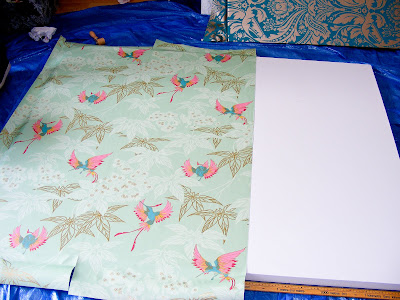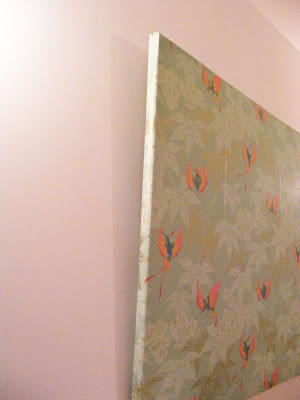How to Wallpaper an Artist's Canvas
From the title of this post, you would be forgiven for thinking that I may actually be about to impart some wisdom on the matter, but fear not dear readers, this project has been approached with my usual mix of haphazardness and blind faith. Mess and chaos did, somewhat inevitably, ensue. Now, our flat has very large, extremely dull, white walls. So, I figured, why not add some colour by using wallpaper - it will be easier than actually creating a painting, right? Especially as I've not picked up a paintbrush for a good few years now. The fact that I have never wallpapered anything in my life is neither here nor there...
So, canvasses and wallpaper acquired, I telephoned my mother for advice. She knows how to wallpaper things, see. We would have to paint the canvases with a thin layer of wallpaper paste, she said, and leave to dry before then pasting the wallpaper. It's called sizing, apparently. So, we covered the floor with a massive tarpaulin (I knew there would be mess. There's always mess) and got to work.
I used Solvite wallpaper adhesive that you have to mix up yourself, divided it into 4 and worked out how much water I needed for the sizing. We mixed the correct quantities (I think - maths not really my area of expertise), but if I were to do this again, I would paint the canvases with a much thicker coat of paste, in order to get the actual canvas part much stiffer than we did.
Unhelpfully, I couldn't find any instructions on the adhesive pack or on the interwebs for how long the wallpaper paste would take to dry. We ended up leaving it overnight, although having left the sized canvasses in a warm room, they were dry in a couple of hours.
So, onto the wallpapering! How hard can this possibly be, I thought. Somewhat obviously, as with most of my experimental projects that seem super-easy in my head, it turned out to actually be quite difficult. Sensibly, I purchased a cheap roll of wallpaper to practice on, as canvasses are sold in pairs, so we had a spare. Less sensibly, I chose as my practice roll a very heavily embossed Anaglypta. Then failed to read the instructions on the roll of paper. This is unlike me, I'm normally very much Instructions Girl, which is good, as the boy is more of a charge in headfirst, scattering instructions in his wake kinda person. Today, he has been enlisted as my glamourous assistant:

Anyway, we mixed up the adhesive again and pasted the paper. Then plonked it straight onto the canvas, without leaving it to soak into the paper. This was the not following instructions part. Still, it all seemed to go okay until we discovered that the edges were conspiring against us and refusing to stick to the canvas. Attempting to line up the second piece was also tricky. So, basically, our join looked rubbish. See?

Second one worked slightly better. More paste under the join seemed to help. Here is my glamorous assistant showing the difference between our first and second joins. Improvement was definitely made.

So, done with the practice one and feeling like we learned some stuff, we moved on to a rather lovely Graham & Brown paper - kind of a dark turquoise with a cool toned metallic gold vintage pattern. This one, I actually read the instructions on the paper, pasted and and left to soak for 5 minutes. Oh, also discovered that it helps to line up the patterns and cut out all the pieces before pasting anything. Just a little tip for you there...
We still had some joining problems. I think the problem is that a wall is nice and solid and you can really press down on the joins, whereas a canvas is a bit more flexible. I was a also a bit worried out getting paste on my lovely shiny paper, so could definitely have used more on the joins. But, it actually looked okay.

The final (and rather more complicated) canvas was a massive 6' x 4' one, to be hung landscape style and papered with Osborne and Little Grove Garden wallpaper, which I have been obsessing over for some years. Small and brighly coloured hummingbirds! Annoyingly, the canvas was slightly too wide for three drops of paper, so we also had to cut a silly little strip for one end. Bah.
Given what we'd learned so far, we were way more liberal with the wallpaper paste for this one, which made the joins stick much better.
Work in progress:


Having stuck down all of the pieces, I then spent the next hour stalking bubbles across the canvas. I may have tendencies to obsessiveness...
So, the next thing on my "what not to do" tips is drench a large frame of wood and canvas with liquid glue, leave it lying in a hot and sunny room and then toddle off down the pub. There were some teensy warping issues on the frame:


Once the canvases were dry, we folded over all the paper edges, having previously decided that trying to paste them to the edges of the canvas would be horrible, and staple gunned them to the back of the frame. Like so:

The boy found the staple gunning part terribly exciting and went off in search of more things to staple. Had the pictures not already looked a bit on the wonky side, I would have probably cut little v shapes out of the corners and folded them in a mitre joint kind of way. But they were, so I didn't.
Hung them on the walls and, apart from the horrible warping on the large frame, they actully don't look too awful. They could have been better, but given the slightly cavalier way we approached the project, they could have been much, much worse.


So, if you're thinking of doing something similar, I hope this little post is of some assistance, as despite extensive Googling, I couldn't find any information on wallpapering an artist's canvas, hence the write up.

